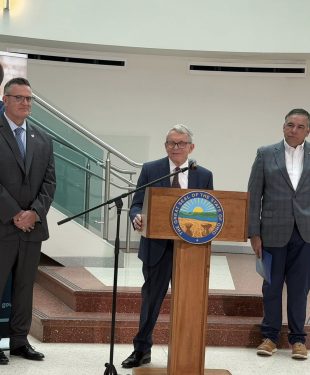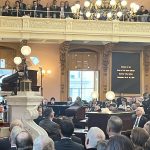By Deba UWADIAE and Taiwo AKINLAMI
The Ohio Chamber of Commerce Research Foundation held a critical discussion on the state’s tax competitiveness, on Tuesday, July 23, 2024 recommending, among others the conduct of a thorough review of state and local taxes to reduce the tax burden and compliance costs for businesses.
The presentation was part of the findings from a comprehensive study conducted in collaboration with Ernst & Young. The event featured key insights from Demetrius Thomas, Executive Director of the Ohio Chamber of Commerce Research Foundation, and Tom Zaino, board member of the Ohio Chamber of Commerce Research Foundation.
Key Findings from the Study:
Demetrius Thomas began the presentation by highlighting the origins and objectives of the study, which started in 2022 under the initiative “Blueprint for Ohio’s Economic Competitiveness.” The study focused on assessing the impact of business taxes on Ohio’s economic landscape, utilizing benchmarks from states such as Indiana, Michigan, Minnesota, Georgia, and Texas.
Thomas emphasized the following key points:
1. Tax Burden Comparison: Ohio’s state-level taxes are generally competitive with those of other benchmark states. However, local taxes are disproportionately high, creating significant administrative burdens due to the multitude of local tax jurisdictions. According to the study, Ohio ranks 39th in the nation for overall tax climate, significantly influenced by local tax complexities. Specifically, Ohio has an effective business tax rate of 10.4%, compared to the national average of 9.2%.
2. Impact on Businesses: The analysis, which included hypothetical business profiles operating over 30 years, revealed that while state taxes remain competitive, local taxes, particularly income taxes, are less so. For instance, businesses in Ohio face a combined state and local tax burden that is 12% higher than the national average. This higher tax burden is due to the presence of 348 distinct tax jurisdictions within the state.
3. Compliance Costs: The study identified that Ohio’s complex local tax system imposes high compliance costs on businesses. Ohio is one of 17 states allowing municipalities to levy their own taxes, with 348 distinct tax jurisdictions, leading to administrative inefficiencies. The compliance cost for businesses in Ohio is estimated to be $1.4 billion annually, with small businesses bearing a disproportionate share of these costs. Additionally, businesses spend an average of 245 hours per year on tax compliance, compared to the national average of 175 hours.
Recommendations for Improvement:
Thomas outlined the study’s major recommendations:
1. Comprehensive Tax Review: Conduct a thorough review of state and local taxes to reduce the tax burden and compliance costs for businesses. The study suggests that streamlining the tax code could save Ohio businesses up to $500 million annually.
2. Simplification of Tax System: Streamline the tax system to minimize the administrative burden on businesses. This could include centralizing tax administration or reducing the number of taxing jurisdictions. Simplification could potentially improve Ohio’s tax climate ranking by up to 10 places. The study estimates that reducing the number of tax jurisdictions to fewer than 100 could decrease compliance costs by 35%.
Tom Zaino, a board member of the Ohio Chamber of Commerce Research Foundation, spoke about his extensive background in tax and economic issues. He highlighted his experience chairing a 2003 bipartisan committee to study state-level taxes and leading a municipal income tax uniformity coalition in 2013-2014. Zaino emphasized Ohio’s progress in tax reforms, including the phase-out of the tangible personal property tax and the introduction of the commercial activity tax, alongside significant personal income tax cuts.
Zaino discussed the current study’s findings, noting that while Ohio’s state-level taxes are competitive, the complexity and high compliance costs of local taxes pose significant challenges. Ohio has 348 distinct tax jurisdictions, contributing to high administrative burdens for businesses. He stressed the importance of streamlining and simplifying Ohio’s tax system to improve competitiveness and facilitate job creation.
Key issues highlighted included:
1. The need for a comprehensive review of state and local taxes to reduce burdens and compliance costs.
2. The impact of property taxes, sales and use taxes, and unemployment taxes on Ohio’s competitiveness.
3. The importance of reducing administrative costs and complexity for businesses, which could save significant resources and improve efficiency.
Zaino concluded by acknowledging the support of the General Assembly and local officials in making Ohio more competitive and reiterated the need for a collaborative approach to tax reform.
Business Community’s Perspective: Mark Swepston’s Insights on Business Challenges and Taxation
Mark Swepston, the fourth-generation owner and president of Atlas Butler, addressed the audience by sharing the historical and contemporary challenges faced by his family-owned business. He emphasized the importance of efficiency and customer focus in their long-standing success.
Swepston highlighted several key issues:
1. Tax Burdens: He mentioned the “bad tax” in Ohio that imposes a 1% tax on all revenue, regardless of profitability, and the significant administrative costs involved in complying with local tax jurisdictions.
2. Operational Challenges: The need to obtain multiple permits, often costing over $150 each, for routine business operations like installing water heaters.
3. Efficiency in Tax Processes: He stressed the importance of making tax processes more efficient, suggesting that centralizing tax administration could reduce burdens on businesses and local governments alike.
4. Emergency Services Responsibility: Swepston pointed out the responsibilities businesses have, such as providing emergency medical coverage for large facilities, and how this adds to operational costs.
He concluded by urging a reevaluation of the tax system to make it more efficient and supportive of businesses, allowing them to focus on providing the best services without being bogged down by administrative complexities.
Q&A Session:
The session concluded with a Q&A segment, where audience members asked about the feasibility and potential impact of the proposed changes. Both Thomas and Zaino addressed concerns, reiterating that the aim is not to reduce revenue for local governments but to streamline the process, thus benefiting both the government and businesses. They also noted that improving tax compliance and reducing administrative burdens could result in better tax collection efficiency, potentially increasing overall tax revenues without raising rates.
Conclusion:
The Ohio Chamber of Commerce Research Foundation’s study highlights critical areas for improvement in the state’s tax system. By addressing these issues, Ohio can enhance its economic competitiveness, attract more businesses, and foster a more business-friendly environment. Implementing the recommended changes could potentially create 30,000 new jobs over the next decade, according to the study. Additionally, simplifying the tax system could increase Ohio’s GDP by 1.5% annually.
(For more information and to join the ongoing discussion, please visit the Ohio Chamber of Commerce Research Foundation’s website Contact: Demetrius Thomas, Executive Director, Ohio Chamber of Commerce Research Foundation, Email: dthomas@ohiochamber.com, Phone: +1 614-228-4201)
Support the New Americans magazine to continue to serve our community with precise news that affects the new American, immigrant and refugee community. https://paypal.com/donate/?hosted_button_id=8LHFS78NRNJJY&source=url




































Leave a Reply
You must be logged in to post a comment.